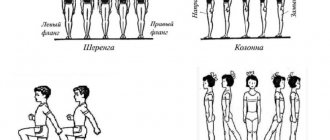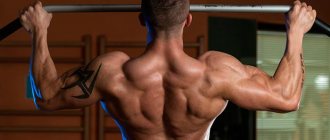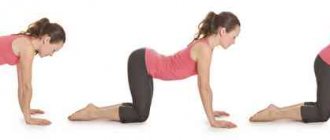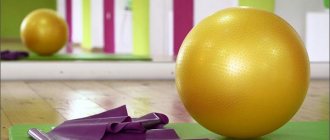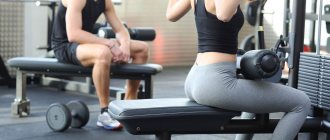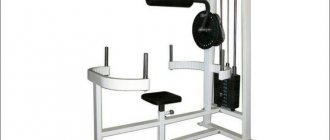The benefits of training
The popularity of hoops and hula hoops is based on their benefits for the body. Most often, ladies who want to lose weight or reduce their waist use them. But, having achieved results, they do not stop because they notice additional advantages:
- the hoop does not take up much space in the apartment, and it can be easily stored behind cabinets or hung on the wall;
- It only takes 30-40 minutes a day to maintain your figure;
- during training, you can watch a movie, listen to music or an audiobook;
- during exercise, the muscles of the back, hips and buttocks, abdomen and sides of the waist are strengthened;
- general physical condition improves;
- blood circulation improves, the heart works better;
- the functioning of the gastrointestinal tract improves.
The first results can be noticed after just a week of training, and then your well-being and appearance will improve every day.
How to choose the right hoop
You shouldn’t take the first one you come across, because if you choose the wrong one, it will be inconvenient for you to study. This is especially important if you are just planning to learn how to spin a hula hoop - the machine must be suitable for you so that you can perform the exercises comfortably.
When choosing, you need to pay attention to two main indicators:
- weight;
- diameter.
Beginners are advised to choose a light projectile - no more than 1.5 kg. Advanced athletes can take a heavier hoop - 2-2.5 kg. This way you can increase the load, which means the results from your training will be more noticeable.
If the hoop is too small or too big, it will constantly fall.
The appropriate diameter depends on your height. Take the hoop and place it on the ground. Its upper part should be at the level of your thigh (pelvic bone). This diameter is considered ideal.
How to spin a hoop correctly
Before you start training, you need to choose suitable clothes. You will need tight-fitting pants and T-shirts that will not interfere with your rotation. But a bare body around the waist (for example, a top) is not suitable - bruises and abrasions may remain.
In addition, certain rules must be observed:
- Always start spinning the hoop at your waist. Even if you want to move to the hips later, start from the waist and gradually lower the hoop lower.
- At first, limit your workout to 15-20 minutes. When you can handle such a load, increase it to 30-40 minutes. Not worth it anymore.
- Tie a thick cloth around your waist and lower back to gradually get used to the pressure on the skin and vertebrae. At first it may be uncomfortable, but when you get used to it, remove the additional layer.
- Don't slouch while exercising—it's important to keep your back straight.
- Eat at least an hour and a half before training. After it, also pause for an hour and do not eat.
- Rotate the hoop evenly in one direction and the other.
- Perform rotation using the abdomen and hips, without using the thoracic region.
- Always warm up before spinning the hula hoop: bending to the sides, squats, stretching.
The training should be carried out in a free room. Make sure that a full rotation of the hoop around your waist will not hit any objects or people. Only after this can you move on to classes.
Duration of training
Beginners need to practice for literally 2-5 minutes. Do not chase the duration of classes; first of all, pay attention to the correct execution of movements.
After mastering the skill of spinning a hoop, begin to increase your training time. Add 60 seconds every day.
Maximum training time is 40 minutes!
Stop when you reach 30-40 minutes per day. The time can be divided into two approaches (morning and evening) for 15-20 minutes. Suitable for those who physically cannot cope with such loads or cannot allocate so much time in their schedule.
Rope for rhythmic gymnastics
Hemp or synthetic, should not have any handles, just one or two knots at each end.
The standard size of a jump rope is 2.5 -3 meters.
https://www.youtube.com/watch?v=https:accounts.google.comServiceLogin
As a rule, the rope you buy is too big, so it needs to be cut to fit the gymnast’s height. It is believed that you need to cut the rope on both sides so that the centering does not change, and tie the same knots at both ends. Your trainer will tell you how many centimeters to trim. It is generally accepted that a jump rope with knots already tied should be higher than the armpits and almost reach the shoulders (you can leave it for small children to “grow” - so that the knots reach their earlobes) when the gymnast stands on it with both feet in the center (legs together).
The knots of a hemp jump rope can be secured by stitching with threads; the knots of a nylon jump rope can be burned.
How he behaves: “They trip over her.” Although it is considered the most flexible, it is with her that training in rhythmic gymnastics begins.
The jump rope is the first apparatus in rhythmic gymnastics, with which the training of female athletes begins. For kids and young gymnasts, a jump rope 2.5 m long made of cotton or polyester is suitable; it is lightweight, flies well, is soft, and does not hit the legs too hard when falling.
For experienced gymnasts, we recommend a nylon jump rope 3 m long, heavy, dense, maintaining its shape in flight and not changing the trajectory of the throw.
Tips for caring for and storing your jump rope:
- Keep away from moisture.
- Wipe off sweat from the jump rope immediately after training with a dry cloth.
- Don't wash it.
- Keep it in a case.
How to learn to spin a hoop
Let's move on to training. The most important thing now is to get rid of fears. Excess tension will interfere with training.
Make sure that:
- You won't be able to knock anything down when you spin the hoop.
- The hoop weighs no more than 1.5 kg (for beginners).
- You wear tight but tight-fitting clothing that covers your waist and lower back.
- Hoop training is not contraindicated for you.
In such conditions there are no risks or dangers. Be prepared that the hoop will fall at first - this is normal. Just pick it up and keep doing it.
Basic technique
First you need to learn how to rotate the hoop around your waist.
- Starting position: straight back, legs together, slightly bent, the edge of the hoop pressed to the lower back at waist level (hold it with both hands at approximately the 2 and 10 o'clock position).
- Turn your body to the side and forcefully spin the hoop in the opposite direction. Immediately open your palms. After this, it is better to raise your hands so that they do not interfere with the movement of the hoop. Place them to the sides to catch the falling hoop. Having learned to twist without falling, you can lock them over your head or bend them at chest level.
- Perform circular movements with your stomach - try to draw a circle with it. The chest and pelvis should not move.
- You need to get into the same rhythm with the hoop so that you move in time. Each time it touches your stomach, push it forward to keep the hoop moving.
- At first, train in front of a mirror to notice mistakes and control your body position.
Pick one workout pace and stick to it. Don't twist too slowly, as there is a greater chance that the hoop will fall. But don’t rush – you can quickly run out of steam.
How to spin a hula hoop on your hips
Only after learning how to rotate the hoop at the waist can you move on to a more complex type of torsion. Because these are the basics, without which it is impossible to move on.
If there is a desire, we study further.
The initial position is the same as in the previous training. You need to start twisting the hoop around your waist. Having caught the rhythm, you need to move the circle down a little so that it slides to hip level.
Push your hips forward with each rotation of the hoop. At the same time, bend and straighten your front leg, transferring the center of gravity to it. The same circular movements, only not with the stomach, but with the hips.
Ribbon for rhythmic gymnastics
The performance ribbon is the lightest (by weight) item in rhythmic gymnastics; it is made of viscose fiber or satin.
We invite you to familiarize yourself with Facial expressions and gestures: who is hiding what?
It consists of a stick (plastic or plexiglass), the tape itself and a fastening carabiner, which is sometimes replaced with a nylon strap.
The length of the stick is 50 – 60 cm (including the carabiner). Ribbon is a single strip of fabric, 4 to 6 cm wide, weighing 35 g or more. The length of the purchased ribbon depends on the age and category in which the gymnast performs at competitions: 14 years and older, MS – 6 m; 9-14 years old, CMS, 1-2 adult category - 5 m; Up to 9 years old, 3 adults.
How it behaves: “It gets tied up.” Reacts to the slightest air fluctuations, even from air conditioners. And by absorbing moisture, it changes its properties - that’s why gymnasts always take an iron with them and often iron the tape.
Ribbon for rhythmic gymnastics can be plain or painted using special aniline dyes. After this, the entire tape is treated with pre-brewed starch, dried and ironed with a hot iron. Immediately before training or competitions, the entire length of the tape must be treated with an antistatic agent in an aerosol package.
The color of the stick is chosen arbitrarily - it must match the color of the ribbon itself or the color of the gymnastic leotard. The length of the stick directly depends on the length of the object - for a 4-4.5 meter ribbon the stick should be 50 cm, for a 5 meter ribbon - 57 cm, for an adult athlete the optimal length of the stick is 60 cm.
For transportation and storage you will also need a drum for tightly twisting the tape, a spare carabiner for fastening and a general case.
The ribbon curling in the hands of a gymnast always attracts the gaze of spectators. A satin or viscose strip is attached with a carabiner or a nylon pigtail to a conical (cylindrical) stick. During training and demonstration performances, athletes use ribbons up to 4 m long. A huge selection of colors allows you to complement a gymnast’s costume to advantage.
Using our table, you can choose the right ribbon for rhythmic gymnastics.
| Gymnast age | Tape length | Tape material | Stick length | Stick material | |
| Master of Sport | 14 years and older | 6 m | Viscose Satin | 60 cm | Plexiglas Plastic Lightweight material |
| Candidate for Master of Sports, 1–2 category | 9–14 years | 5 m | 55–57 cm | ||
| 3rd category and below | Up to 9 years | 4 m | 50 cm |
https://www.youtube.com/watch?v=upload
Tips for caring and storing gymnastics ribbon:
- Wash in warm soapy water, water temperature no higher than 30°C.
- Use shampoo for washing.
- By starching the ribbon, you will maintain its elasticity.
- Before the performance, treat the tape with an antistatic agent, and it will not stick to the costume during the performance.
- Store tightly wound onto the reel.
Analysis of common mistakes
Understanding that you are doing something wrong is quite simple. In this case, the hoop will fall to the floor or fall down.
Most often, the problem lies in the choice of hoop - it doesn’t suit you. If your movements are correct and falls continue, try choosing equipment with a larger diameter.
Try again and again until you find the right point from which you can push the hoop to move it firmly around your waist.
How to prevent a hoop from falling
Sometimes, despite all the efforts of the twister, the hoop begins to fall below the waist. You need to learn how to deal with this situation without stopping the rotation.
- Bend your knees under the hoop, accompanying this with a quick movement of your hips to increase the rotation of the hoop and return it to waist level. You need to turn your shoulders back when you bend your knees to prevent the hoop from falling completely.
- Move your body vigorously in the direction in which the hoop is spinning. Push him actively with your hips.
The main secret of returning the hoop to its original position lies in pushes and rapid rotation of the body. The speed should be higher than with normal hoop spinning. It will seem to “fly up” up your body from the effort.
How to avoid hoop displacement
There are often situations when the hoop sags to one side. This is due to the fact that you lean on one leg more than the other. Or push the hoop harder in one direction with your hips.
To align the movement of the hoop, you need to keep your posture level and your legs straight. The feet should be at the same level.
Clubs for rhythmic gymnastics
Rubber or synthetic. Length - 40 - 50 cm, weight - at least 150 g (each). The diameter of the head is no more than 3 cm.
Junior (children under 10 years old) Sasaki clubs have
the length is only 36 cm. Also, children under 10 years old can immediately start working with Amaya clubs with a length of 41 cm. The wide part is called the body, the narrow part is the neck.
The neck and body are usually covered with adhesive tape - plain or multi-colored.
When choosing a material for making a projectile, you need to remember that plastic clubs are easier to handle - when they fall on the floor, they do not give a strong rebound, but if they accidentally fall on an athlete, they can cause a rather painful injury.
To prevent slipping, it is recommended to use implements with velvet handles. How they behave: They are considered the most traumatic: despite their low weight, they sometimes cause bruises and even cuts. Especially in group exercises where they are thrown very high.
We suggest you read: How to choose an effective medicine for warts on your hands
When buying clubs, give preference to combined or soft rubber equipment. The combination mace has a rubber head connected to a plastic handle. The girls are not afraid to throw them, catch them, and perform various tricks. The budget option is still shells made from plastic.
The size of the mace is selected taking into account the age range:
- 36 cm for gymnasts 3-7 years old;
- 40-41 cm for gymnasts 8-11 years old;
- 44-45 cm for gymnasts over 11 years old.
An important rule for choosing clubs! A correctly selected projectile reaches the middle of the shoulder. We check this way: place the small head of the club in your palm. Straighten your arm.
A standard projectile weighs 150 g, a children’s one - 100 g. Maces are available on the market in different colors. You can add individuality to the attribute with colored tape with an adhesive layer, rhinestones, and stickers.
Tips for caring for and storing clubs:
- Wipe with a damp soft cloth.
- A cotton pad soaked in sunflower oil will help remove sticky stains from the mace.
- Store the projectile only in the case.
